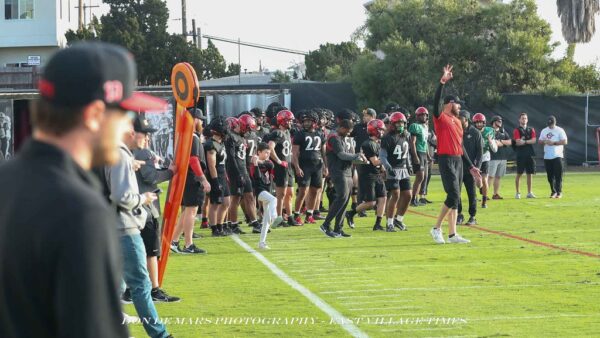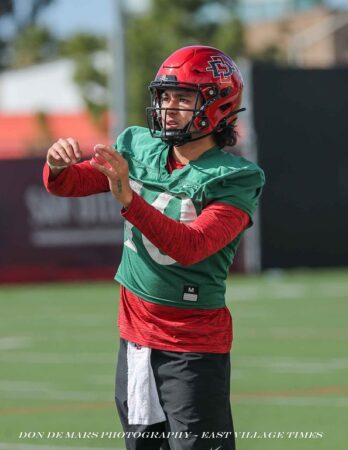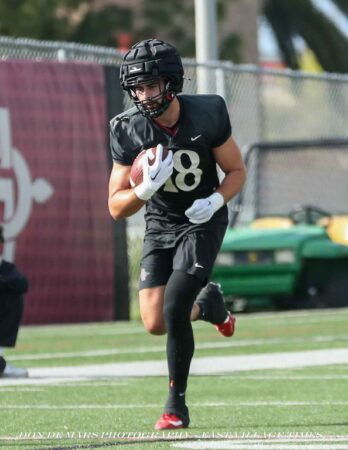Middle school teammates revamp SDSU’s recruiting efforts

Sean Lewis closes out practice as recruits look on. (Credit: Don De Mars/EVT)

SDSU head coach Sean Lewis and director of player personnel Sean Dillon won their first championship together in middle school. They grew up together in Oak Lawn, Illinois, a suburb of Chicago with a population under 60,000.
Lewis played quarterback. Dillon competed at fullback. They brought a title back to St. Linus Catholic School as eighth graders.
They kept in touch through high school, college, and into their coaching years as Lewis grew into an offensive guru and Dillon an expert in recruiting with stops at Oregon, UCF, and Nebraska. Over the years, the former teammates bounced ideas off each other, organically creating a common vision of how to acquire players.
“It’s just bringing like-minded individuals in that see the process the same way,” Lewis said on Tuesday when asked why he hired his longtime friend. “They’re going to be detailed and organized to lead in that very critical area of what we’re building and what we’re doing.”
In under three months, Dillon has led the Herculean task of laying the foundation of Lewis’ protocols, wrapping up the Class of 2024, adding 24+ transfers, and kick-starting the next two recruiting cycles. To accomplish this endeavor, SDSU had to innovate its recruiting efforts. In doing so, they may have found a workaround for one of the program’s biggest disadvantages.
Existing in the lower-middle class of college athletics, SDSU’s recruiting budget is not as robust as schools with deeper pockets. Typically, that creates an advantage for wealthier institutions that can hire more people or outside contractors to thoroughly evaluate more recruits.
A norm across college football is for the recruiting staff to do the legwork of watching film to see if an assistant coach should evaluate a higher schooler. Under the previous regime at SDSU, three or four people canvased upward of 1,000 players from each grade level before advancing them to the next tier.

Lewis and Dillon have turned the process on its head. The assistant coaches are the first evaluators of the prospects in their recruiting areas. SDSU now has ten more people involved in that initial step.
“Coach Lewis was awesome with scheduling each day a talent acquisition meeting where they have time throughout the day to solely watch film as an area recruiter, as a position coach, (or) as a staff,” Dillon explained on an upcoming episode of The SDSU Podcast. “So, we’ve probably watched on the 2025 class, I’m guessing 600 guys, 700 guys in a two-month period. That was impressive. And this is the first time I’ve done it this way.”
Shifting his methods after 14 years in the industry, Dillon is reinventing the proverbial recruiting wheel. SDSU is hoping Dillon’s designs are as innovative off-the-field as Lewis’ tactics are on it.
“This is a talent acquisition business,” Lewis explained. “I wouldn’t be standing in front of you if it wasn’t for the great players that I’ve coached in the past, and that holds true for all of our coaches as well. We’re only as good as the players that we get to coach and their belief and buy-in into what we’re doing.”
California Dreaming
As Lewis suggested in his introductory press conference, SDSU’s recruiting focus takes an inward-out approach. The offensive staff is divided into recruiting areas. Native San Diegan Mike Schmidt oversees San Diego. QB coach Matt Johnson focuses his efforts on Orange County. Los Angeles legend Darian Hagan leads the team in his backyard. Lanear Sampson has the San Fernando Valley. Zac Barton canvases schools from San Jose to San Francisco.

Defensively, a second San Diegan, Demetrius Sumler, searches for Hometown Heroes. His responsibilities also extend into the Inland Empire. DL coach David Lose works in the areas around Ventura and Simi Valley. EDGE coach Rob Aurich has the East Bay area in Northern California. Defensive coordinator Eric Schmidt has Sacramento to Modesto. Safeties coach CJ McGorisk has the deserts and the Fresno to Bakersfield corridor.
There are a few areas that garner special attention outside of the Golden State. Coach Johnson covers the state of Nevada. Barton and Eric Schmidt tag team Phoenix, Arizona. Dallas, Texas, is recruited by Sampson, a native Texan, and McGorisk. Western states like Washington, Oregon, are managed by graduate assistants.
“Our goal was to make sure to take care of California first,” Dillon said. “We want to recruit the state. I feel like we don’t need to go far to get a recruiting class. So, we wanted to make sure every coach had a recruiting area in California.”
“We wanted to make sure San Diego was the most important location. That’s why we split up San Diego with coach Schmidt and coach Sumler. Phoenix was great because it was a four-hour away drive so we wanted two coaches there. And then, the Bay Area has been awesome for us. I think we’ve had 10, 20, 25 offer-kids come visit us in the last two weeks from the Bay Area already.”
From the pipeline to the practice field
After the area recruiters make their initial recommendations, the evaluation is just beginning. Players from one area can play a variety of positions. Those who pass the first inquiry are shuffled to the respective position coaches for a second look. Dillon tries to make this process as efficient as possible. If the staff does not understand what a position coach desires in a player, there is the potential for wasted time that the staff cannot afford.
Early in his tenure, Dillon walked his colleagues through a process where each coach listed his “critical factors” for athletes at his position. OL coach Mike Schmidt, for example, desires linemen with the right frame, feet, and flexibility, who finish plays. Armed with Schmidt’s “Four Fs,” every area recruiter can judge talent through the provided lens. Dillon’s design ensures every SDSU recruit passes through a similar system.

If an athlete’s film entices both the area and position coaches, the in-depth evaluation begins. Dillon and his staff create “point-of-attack films.” Preferring to watch full games to highlight tape, they gather as much data as they can on a potential offeree.
Not only does SDSU’s approach help them sift through the myriad of options to find the players who fit its culture, but it also frees the staff to laser in on their targets, confident in their pursuit. Once an offer is given, every avenue is exhausted to bring that player to The Mesa.
Among the newer methods is a “power hour” on Wednesdays, where the staff gathers in a room, and Dillon gives them a focused list of phone calls to make. Lewis insists on being part of those conversations, and it is not uncommon for the phone to be passed among the coaches because recruiting at SDSU is a team effort.
This spring, practices have mostly been closed to the media, but open to prospective players. Judging by social media, these unofficial visits have been a hit. Coordinating these trips falls under Dillon’s purview.
“Having the ability for those young men and their families to come out to practice and really see and experience and feel our culture, our program, our city, all of that, is everything,” Lewis explained. “At the end of the day, those families and that young man is basically saying, ‘Hey, we trust you and your staff, coach, with my career and with my future.’ And that’s something that we don’t take lightly. So, we want to be able to pull back the curtain, come in meetings, be able to experience everything and see us for who we are. So, that when we’re talking, and it’s a quote, unquote ‘recruiting conversation,’ it’s not, it’s just us being ourselves. We feel like we’re building something very special here, that’s not for everyone but it’ll be for the right people. They’ll see it, they’ll recognize it, they’ll identify that, and they’ll decide to be a part of it.”
Opportunity Cost
Every moment spent pursuing the next group of Aztecs comes at the expense of what Lewis and his staff could be doing with that time. One opportunity cost of watching film on recruits is not watching as much of the practice film.
A key piece of Dillon’s role is to make the carved-out recruiting time as unintrusive as possible to efforts of building the 2024 Aztecs. The recruiting staff meticulously plans the daily activities they need the coaches to do. Without having to exert extra energy planning or setting up, Lewis and his assistants can excel in both arenas.
Hard work and long hours are also needed. Coach Johnson wakes up at 4:30 am each day. Media sessions not held after practice have to be squeezed into lunch breaks. The staff is modeling the effort they expect from their players.
The team will have a break next week. Lewis said it would be a time for his lieutenants to recharge and for those who moved to San Diego to settle in more. A visit to the San Diego Zoo with his family is on the head coach’s agenda. During this time away, Lewis added, the staff will also have some recruiting responsibilities.
The attractiveness of sports is that, unlike life, there is a clear scoreboard by which to weigh results. The product on the field in the fall, the strength of the 2025 recruiting class, and their ability to sustain success will ultimately judge Lewis’ and Dillon’s reorganization of SDSU’s player development. In the short term, they have already succeeded at shortening the usual transition between coaching changes.
My earliest sport’s memory involve tailgating at the Murph, running down the circular exit ramps, and seeing the Padres, Chargers and Aztecs play. As a second generation Aztec, I am passionate about all things SDSU. Other interests include raising my four children, being a great husband and teaching high school.